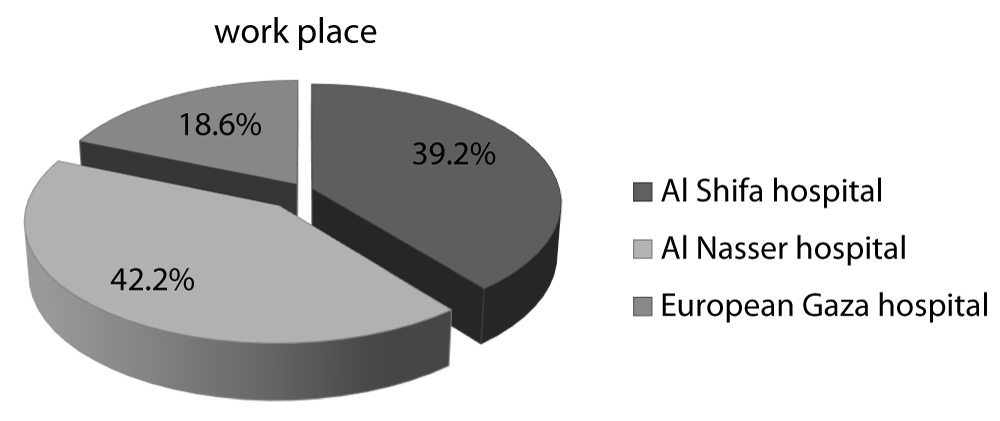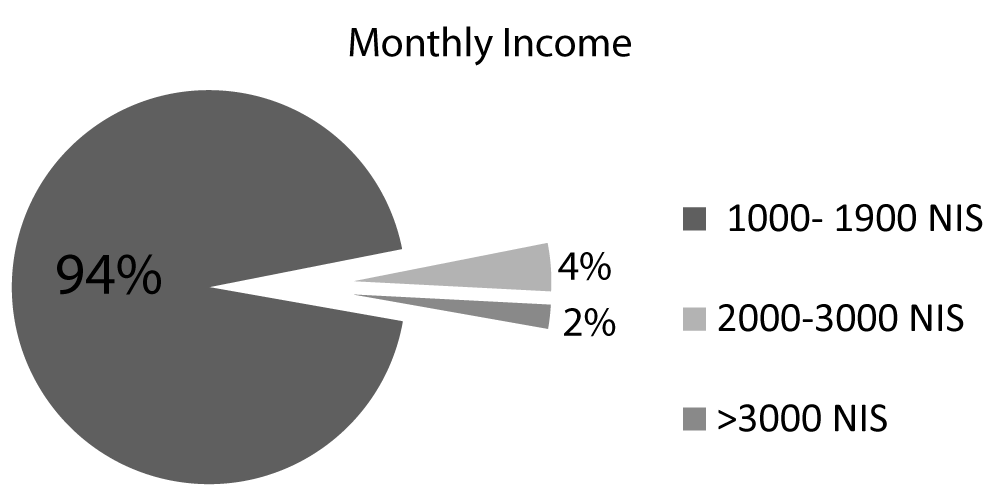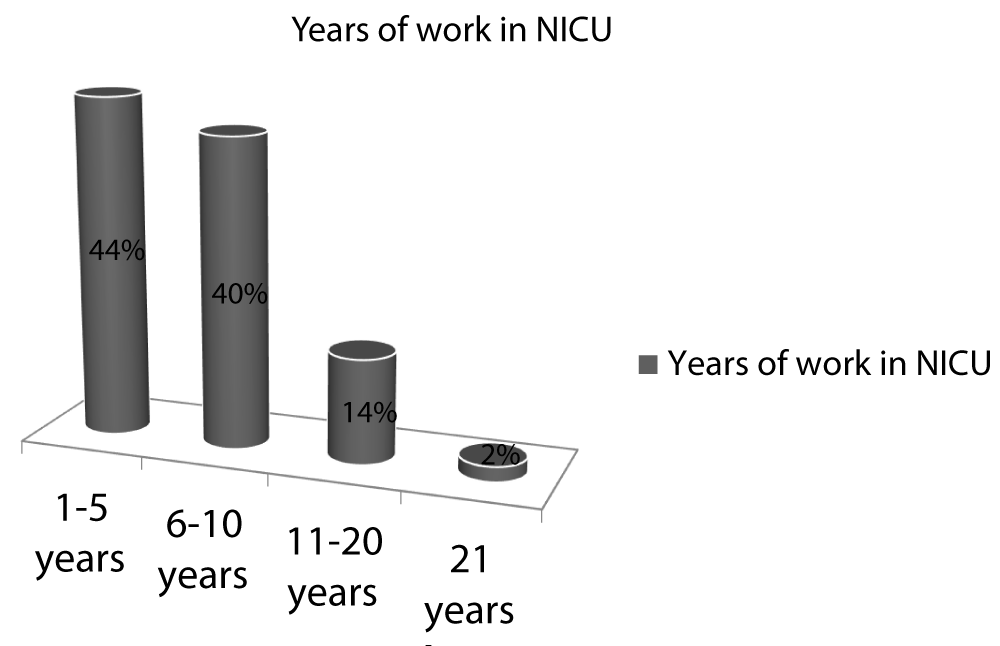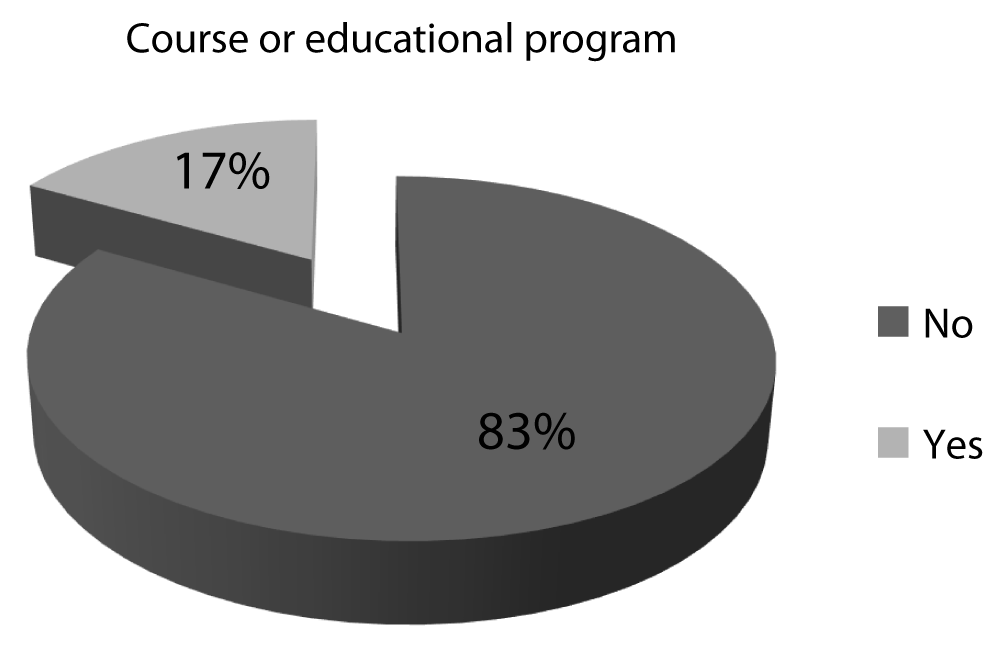More Information
Submitted: June 26, 2021 | Approved: July 05, 2021 | Published: July 06, 2021
How to cite this article: Qasim YKS, Abdeljawad H, Abusafia AH. Nurses' knowledge and practice in assessment and management of neonatal pain at Governmental Hospitals in Gaza Strip: A cross sectional study. Clin J Nurs Care Pract. 2021; 5: 038-042.
DOI: 10.29328/journal.cjncp.1001035
Copyright License: © 2021 Qasim YKS, et al. This is an open access article distributed under the Creative Commons Attribution License, which permits unrestricted use, distribution, and reproduction in any medium, provided the original work is properly cited.
Keywords: Nurses; Assessment; Management; Gaza; Hospital
Nurses' knowledge and practice in assessment and management of neonatal pain at Governmental Hospitals in Gaza Strip: A cross sectional study
Yunis KS Qasim1*, Hamza Abdeljawad1 and Ali H Abusafia2
1Faculty of Health Professions, Al-Quds University, Palestine
2Nursing Program, School of Health Sciences, Universiti Sains Malaysia, Kelantan, Malaysia
*Address for Correspondence: Yunis KS Qasim, Faculty of Health Professions, Al-Quds University, Palestine, Tel: + 970597186600; Email: [email protected]
Objective: The study aimed to investigate neonatal nurses' knowledge and practices related to pain assessment and management that may contribute to improve the quality of pain management by nurses at Neonatal Intensive Care Units (NICUs) of governmental hospitals in Gaza Strip.
Design: The study design was quantitative, descriptive cross sectional, conducted at the NICUs affiliated to the governmental hospitals "Al Shifa Hospital - Al Nasser Pediatric Hospital - European Gaza Hospital".
Materials and Methods: The sample consisted of all nurses working in NICUs. The total number of nurses was 102. The data were collected from study participants by using a self-administered questionnaire. The response rate was 100%. The data collected were analyzed by using descriptive and inferential statistical tests with level of statistical significance at p < 0.5.
Results: The results showed that nurses had very low of knowledge level with mean percentages (59.42%) and very low of practice level with mean percentages (58.33%).
Conclusion: Therefore, the study recommended to developing course or educational program related to assessment and management of neonatal pain to promote their integrated pain management care for neonates.
Pain is “an unpleasant sensory and emotional experience associated with actual or potential tissue damage, or described in terms of such damage. Pain of any origin comprises an individual’s life. The prevention and management of pain is an important aspect of health care worker [1]. There are four main vital signs routinely monitored by medical professionals and health care providers include body temperature, pulse rate, respiration rate and blood pressure, International guidelines for pain management in the Neonatal Intensive Care Unit (NICU) suggest that pain is the fifth vital sign, and it should be assessed. Nurses’ neonatal pain assessment and management have improved over the years [2].
Painful experiences in the neonatal period may result in physiological and behavioral alterations, as well as changes in the development of the nervous system, which can provoke considerable damage in the future. However, several studies indicate that hospitalization in (NICU) includes a high number of painful procedures, most of them necessary for diagnosis and treatment [3].
Nurses play a vital role in the management of pain of their patients and the role is even bigger in the underdeveloped premature neonatal population. Infants cannot voice what they need to be said therefore the nurse must prove to be the advocate and voice of the client. The nurses’ goal of pain management in neonates is to minimize the experience of pain and maximize the neonate’s capacity to cope with and recover from the many painful procedures in the NICU. The nurse must maintain a balance between pain relief and adverse effects of analgesics. This requires that the nurse have knowledge and feel comfortable providing pharmacologic interventions as well as non-pharmacologic interventions [4].
Study design
This is a quantitative analytic cross-sectional study conducted to investigate neonatal nurses' knowledge and practices related to pain assessment and management in the governmental hospital at G.S. The data collected via self-administered questionnaire for nurses in neonatal departments.
Study population
The population of this study consists of all nurses working in third level in NICUs of the three governmental hospitals (Al Shifa' Hospital- Al Nasser Pediatric Hospital- European Gaza hospital) at G.S. The total number of nurses working in these departments are 102 nurses " Al Nasser Pediatric Hospital (43) - Al Shifa' Hospital (40) - European Gaza hospital (19) “with different academic level (Diploma, Baccalaureus and Master).
Study setting
The setting of the study is in third level in NICUs of the governmental hospital (Al Shifa' Hospital - Al Nasser Pediatric Hospital - European Gaza hospital) at G.S; these three hospitals have third level of NICUs.
Study period
The study was conducted in the period between Jan 2019 to Nov 2019. Data collection have two weeks to complete in Oct 2019. Data analysis and discussion were finished at Nov 2019. The study took approximately 11 month in total from its beginning.
Sample size and sampling
All nurses working in NICUs of the governmental hospital (Al Shifa - Al Naser - European Gaza hospital) at G.S, about 102 nurses were included in the study “census sample”.
Eligibility criteria
Inclusion criteria: All nurses working in NICUs of the targeted governmental hospitals at G.S during the period of the study and who are willing to participate in the study.
Exclusion criteria: Other nurses in the hospital who work in the NICUs as nurse students and volunteers.
Study instruments and tools
A self-administered questionnaire constructed by the researcher himself based on the review of the literature and past experiences to assess the knowledge and practice of the nurses regarding to pain assessment and management. The questionnaire validated by disseminating this questionnaire to a panel of experts.
The first part of the questionnaire covered the respondents’ demographic information which includes age, sex, level of education, Current position, workplace, average monthly income, work experience, in-service course or educational program.
The second part of the questionnaire developed by the researchers to measure knowledge of the participants towards pain assessment and management in NICUs.
The third part of the questionnaire developed by the researcher to measure practice of the participants towards pain assessment and management in NICUs.
Scoring of the questionnaire
The scores for knowledge and practice of participants were categorized in accord with McDonald‘s [5] learning outcomes.
This McDonald categorized the learning outcomes of multiple choice examinations into five grades (A, B C, D, and F)
or five levels (very high, high, moderate, low, and very low) as follows:
A Very low < 60%
B Low 60% - 69.99%
C Moderate 70% - 79.99%
D High 80% - 89.99%
F Very high 90% - 100%
Validity of the instrument
The constructed questionnaires were sent to eight experts to validate the questions and its relation to the domains that reflect the study. Comments of the experts were considered and modification was performed accordingly.
Reliability: The reliability of instrument was demon-strated by a Cronbach’s Alpha, it was 0.734.
Pilot study
The researcher performed a pilot study in Al Nasser Pediatric Hospital, Al Shifa' Hospital and European Gaza hospital after receiving the approval to perform it from the hospitals general directorate. A pilot study of 30 nurses to ensure reliability of instrument, some minor change and modification were performed without any effect on the main domains were included.
Response rate: The total number of target population was 102 subjects. 102 of them positively responded with response rate of 100%.
Data entry and analysis
The collected data entered into the computer software Statistical Package for Social Science (SPSS) Program, the stages of data analysis included coding the questionnaire, data entry, data cleaning, constructing frequency table for all the study variables. The statistical tests used for analysis of data is descriptive statistics as frequencies, range, percentage, mathematical mean and standard deviation and inferential statistical tests as, t - test, and one-way ANOVA. And Pearson correlation were used. All analysis and observed differences will be considered statistically significant at the level of p - value equals to or less than 0.05.
This chapter illustrates the results of statistical analysis of the data from 102 nurses', including descriptive analysis that presents the socio-demographic characteristics of the study sample and answers to the study questions. In this chapter, the results of this study are presented under the following headings:
1. Characteristics of the study participants.
2. Levels of nurses' knowledge and practice regarding neonatal pain assessment and management among neonatal nurses.
Characteristics of the study participants
This section presents description of study sample socio-demographic characteristics including age of subjects, gender, education level, job position, as well as, variables about workplace, monthly income, year of work in NICU, course or educational program related to assessment and management on neonatal pain at NICU (Table 1.1).
| Table 1.1: Characteristics of the study participants (n = 102). | |||
| Variables | categories | Frequency | Percent |
| Age | < 30 | 50 | 49.0 |
| 30 - 40 | 46 | 45.1 | |
| > 40 | 6 | 5.9 | |
| Gender | Male | 63 | 61.8 |
| Female | 39 | 38.2 | |
| Education level | Diploma | 17 | 16.7 |
| BSN | 80 | 78.4 | |
| MSN | 5 | 4.9 | |
| Current position | Nurse | 82 | 80.4 |
| Senior staff nurse | 17 | 16.7 | |
| Head nurse | 3 | 2.9 | |
Table 1.1 shows that nearly half (49%) of study participants' ages were at age group (< 30). There is newly employment of nurses since several years and the big numbers of employees retired in the last years could explain this result, these results matched with the study result conducted by Lake [6] who found that (52%) of the nurses were at age group (< 30). In addition, this table shows that (61.8%) of the study participants were male, compared to (38.2%) were female. This result considered against the historical background of female dominant in nursing profession [7]. This result inconsistent with study conduct by Costa, et al. [8] who found (98%) were female and only (2%) was male. Also, these results show that most of the study participants (78.4%) had bachelor degree which consider positive point to provide appropriate pain management to neonates, on the other hand there is Diploma (16.7) and only (4.7%) of the study participant had MSN degree but not related to pediatric field. These results similar to result of study conduct by Martinez [9] who found that (59%) of nurses carried bachelor degree, and (8%) of sample were MSN level and (33%) were diploma level. There is current position were as: nurse (80.4%), senior staff nurse (16.7%) and head nurse (2.9%).
In terms of workplace Figure 1.1 shows that (42.2%) of study participants were working in Al Nasser Pediatric Hospital, and (39.2%) of study participants were working in Al Shifa Hospital, and lastly (18.6%) were working in European Gaza Hospital.
Figure 1.1: Distribution of the study participants according to workplace (n = 102).
In addition, these percentages of the study participants reflect only the employed nurses. Although Al- Shifa Hospital has a larger number of incubators, the number of nurses relatively small due to the researcher exclude volunteers and students from sample
In terms of monthly income Figure 1.2 shows that (94%) of study participants receive a salary 1000_1900 NIS monthly, and (4%) of study participants receive a salary 2000_3000 NIS monthly, and lastly (2%) were receive a salary > 3000 NIS monthly.
| Table 1.2: Levels of knowledge and practice regarding neonatal pain assessment and management among neonatal nurses. | ||||
| Study domains | Max score | Mean score (SD) |
Mean percentage | Level category |
| Knowledge | 14 | 8.32 (2.15) | 59.42 | Very low |
| Practice | 24 | 14.08 (3.70) | 58.33 | Very low |
Figure 1.2: Distribution of the study participants according to monthly income (n = 102).
Figure 1.3 shows that (44%) have experience in NICU (1- 5) years and (40%) have experience (6-10). This result matched the result of a study conducted by Mehrnoush [10] who found that (50%) had years of experience in NICU between one to five years. This result inconsistent with study conducted by Abd El-Aziz, et al. [11], who found that (26%) had years of experience in NICU between one to five years.
Figure 1.3: Distribution of the study participants according to work experience in NICU (n = 102).
The big numbers of employees retired in the last years could explain the few years of unit experience. In addition, the (44%) of study participants had years of experience in NICU less than five years may be resulted from rotating nurses through units (NICU, SCBU and Baby Friendly) within the hospital or to another departments in hospital. This (1-5) years considered few years of study participants’ experiences that may be considered an important chance to increase nursing practices depends on evidence-based practices rather than traditional department experiences.
Study participants according to participation in course or educational program related to assessment and management on neonatal pain at NICU
Figure 1.4 shows that the majority (83%) of study participants didn’t receive any course or educational program related to assessment and management on neonatal pain at NICU, while only (17%) of nurses received it. This result match to result of study conduct by Abd El- Aziz, et al. [11] who found that (70.6%) didn’t receive training courses about neonatal pain and (29.4) received training courses about neonatal pain. This result inconsistent with study conducted by Martinez [9], who found that (62%) of study participants have received educational program related to assessment and management on neonatal pain and (20%) didn’t receive any educational program.
Figure 1.4: Distribution of study participants according to participation in course or educational program related to assessment and management on neonatal pain at NICU.
Knowledge and practice regarding neonatal pain assessment and management among neonatal nurses
To determine level of knowledge and practice pain assessment and management among nursing who working in NICU in governmental hospitals in Gaza strip, descriptive statistic include measure of mean, SD and percentage.
Table 1.2 shows that the knowledge and practices mean scores of study participants were (8.32) and (14.08) respectively. The mean percentages were (59.42%) for knowledge and (58.33%) for practice which were categorized as very low level depend on McDonald's standard. These results approximately matched with the study conducted by Abdel Razeq, et al. [12] who found knowledge and practice deficit about neonatal pain. Also, the result of this study congruent with Abd El-Aziz, et al. [11] who found poor nurses' knowledge and practice regarding neonatal pain assessment and management in NICU. While the results of this study inconsistent with the study conducted by Maghami, et al. [13] who showed there was moderate to high nurses' knowledge (71.71%) and practice (68.2%).
Based on researcher’s point of view, when comparing finding from this study with previously published studies conclude there is significant problem of poor knowledge and practice held by nurses caring for neonates experiencing pain.
The study finding showed that nurses had very low level of knowledge and practices toward neonatal pain assessment and management, the mean percentage were (59.42%) for knowledge and (58.33%) for practices.
Recommendations
1. There is a need to design course or educational program related to assessment and management of neonatal pain to update and enhance the knowledge and practice of neonatal nurses.
2. Health care providers should address the use of non-pharmacological and pharmacological pain management among neonates at NICUs.
3. Policies should address the integrative approach of pain management among neonates at NICUs
4. Further research study may be needed after implementing educational program for nurses on integrative approach for assessment and management of neonatal pains at NICUs.
We would like to express our heartfelt gratitude to the staff nurses who have participated in this study for their time and truthful answers.
- Kumar K, Elavarasi P. Defnition of pain and classifcation of pain disorders. J Adv Clin Res Insights. 206; 3: 87–90.
- Gradin M, Eriksson M. Neonatal pain assessment in Sweden – a fifteen-year follow up. Acta Pdiatrica. 2011; 100: 204–208. PubMed: https://pubmed.ncbi.nlm.nih.gov/20804461/
- Sposito NPB, Rossato LM, Bueno M, Kimura AF, Costa T, et al. Assessment and management of pain in newborns hospitalized in a Neonatal Intensive Care Unit: a cross-sectional study. Rev Latino-Am. Enfermagem. 2017; 25: e2931. PubMed: https://pubmed.ncbi.nlm.nih.gov/28902934/
- Nicolet E, Annequin D, Biran V, Mitanchez D, Tourniaire B. Pain Management in Newborns From Prevention to Treatment. Pediatric Drugs. 2010; 12: 353-365. PubMed: https://pubmed.ncbi.nlm.nih.gov/21028915/
- McDonald‟s ME. Systemic assessment of learning outcome: Developing multiple choice examinations. Sudbury MA: Jones and Bartiett publishers. 2002.
- Lake S. Barriers to Effective Pain Management in Preterm and Critically Ill Neonates. University of Kentucky, Lexington, Kentucky (Doctoral theses published). 2013.
- Christensen M. Men in nursing: The early years. J Nur Educat Practice. 2017; 5: 94.
- Costa T, Rossato L, Bueno M, Secco I, Sposito N, et al. Nurses’ knowledge and practices regarding pain management in newborns. Rev Esc Enferm USP. 2017; 51: e03210. PubMed: https://pubmed.ncbi.nlm.nih.gov/28403366/
- Martinez G. Factors that Influence Implementation of Pain Management Strategies in the Neonatal Intensive Care Unit. University of Central Florida, Orlando, Florida. 2014.
- Mehrnoush N, Ashktorab T, Heidarzadeh M, Momenzadeh S, Khalafi J. Pain Management Perceptions of the Neonatal Nurses in NICUs and Neonatal Units in Ardebil, Iran. Iranian J Neonatol. 2016; 4: 23–29.
- Abd El-Aziz D, Abd El-Aziz M, Adly R, El Sallab S. Improving Nurses' Performance Towards Non- Pharmacological Pain Management Among Neonates In Neonatal Intensive Care Unit. J Nurs Health Sci. 2018; 4: 83-97.
- Abdel Razeq N, Akuma A, Jordan S. Status of Neonatal Pain Assessment and Management in Jordan. Pain Manag Nurs. 2016; 4: 239-248. PubMed: https://pubmed.ncbi.nlm.nih.gov/27108085/
- Maghami M, Aghababaeian H, Majin SA, Moosavi A, Tahery N. Knowledge, attitude and performance of the nurses working in neonatal wards about treatment of pain in neonates. J Chem Pharmaceut Sci. 2016; 4: 2796–2801.



